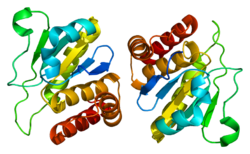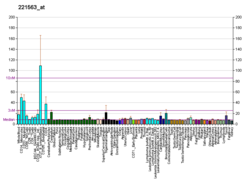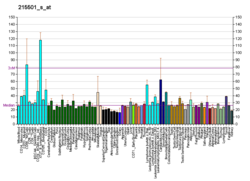Protein-coding gene in the species Homo sapiens
Dual specificity protein phosphatase 10 is an enzyme that in humans is encoded by the DUSP10 gene .[ 4] [ 5] [ 6]
Dual specificity protein phosphatases inactivate their target kinases by dephosphorylating both the phosphoserine/threonine and phosphotyrosine residues. They negatively regulate members of the MAPK superfamily (MAPK/ERK, SAPK/JNK, p38), which is associated with cellular proliferation and differentiation. Different members of this family of dual specificity phosphatases show distinct substrate specificities for MAPKs, different tissue distribution and subcellular localization, and different modes of inducibility of their expression by extracellular stimuli. This gene product binds to and inactivates p38 and SAPK/JNK, but not MAPK/ERK. Its subcellular localization is unique; it is evenly distributed in both the cytoplasm and the nucleus. This gene is widely expressed in various tissues and organs, and its expression is elevated by stress stimuli. Three transcript variants encoding two different isoforms have been found for this gene.[ 6]
Interactions
DUSP10 has been shown to interact with MAPK14 [ 7] [ 8] [ 9] MAPK8 .[ 4]
References
^ a b c GRCm38: Ensembl release 89: ENSMUSG00000039384 – Ensembl , May 2017^ "Human PubMed Reference:" . National Center for Biotechnology Information, U.S. National Library of Medicine .^ "Mouse PubMed Reference:" . National Center for Biotechnology Information, U.S. National Library of Medicine .^ a b Tanoue T, Moriguchi T, Nishida E (Aug 1999). "Molecular cloning and characterization of a novel dual specificity phosphatase, MKP-5" . J Biol Chem . 274 (28): 19949– 56. doi :10.1074/jbc.274.28.19949 PMID 10391943 . ^ Theodosiou A, Smith A, Gillieron C, Arkinstall S, Ashworth A (Jan 2000). "MKP5, a new member of the MAP kinase phosphatase family, which selectively dephosphorylates stress-activated kinases" . Oncogene . 18 (50): 6981– 8. doi :10.1038/sj.onc.1203185 PMID 10597297 . ^ a b "Entrez Gene: DUSP10 dual specificity phosphatase 10" .^ Tanoue T, Moriguchi T, Nishida E (Jul 1999). "Molecular cloning and characterization of a novel dual specificity phosphatase, MKP-5" . J. Biol. Chem . 274 (28). UNITED STATES: 19949– 56. doi :10.1074/jbc.274.28.19949 ISSN 0021-9258 . PMID 10391943 . ^ Tanoue T, Yamamoto T, Maeda R, Nishida E (Jul 2001). "A Novel MAPK phosphatase MKP-7 acts preferentially on JNK/SAPK and p38 alpha and beta MAPKs" . J. Biol. Chem . 276 (28). United States: 26629– 39. doi :10.1074/jbc.M101981200 ISSN 0021-9258 . PMID 11359773 . ^ Tanoue T, Maeda R, Adachi M, Nishida E (Feb 2001). "Identification of a docking groove on ERK and p38 MAP kinases that regulates the specificity of docking interactions" . EMBO J . 20 (3). England: 466– 79. doi :10.1093/emboj/20.3.466 . ISSN 0261-4189 . PMC 133461 PMID 11157753 .
Further reading
Martell KJ, Angelotti T, Ullrich A (1998). "The "VH1-like" dual-specificity protein tyrosine phosphatases" . Mol. Cells . 8 (1): 2– 11. doi :10.1016/S1016-8478(23)13385-1 PMID 9571625 . Teng CH, Huang WN, Meng TC (2007). "Several dual specificity phosphatases coordinate to control the magnitude and duration of JNK activation in signaling response to oxidative stress" . J. Biol. Chem . 282 (39): 28395– 407. doi :10.1074/jbc.M705142200 PMID 17681939 . Tao X, Tong L (2007). "Crystal structure of the MAP kinase binding domain and the catalytic domain of human MKP5" . Protein Sci . 16 (5): 880– 6. doi :10.1110/ps.062712807 . PMC 2206639 PMID 17400920 . Nonn L, Duong D, Peehl DM (2007). "Chemopreventive anti-inflammatory activities of curcumin and other phytochemicals mediated by MAP kinase phosphatase-5 in prostate cells" . Carcinogenesis . 28 (6): 1188– 96. doi :10.1093/carcin/bgl241 PMID 17151092 . Jeong DG, Yoon TS, Kim JH, et al. (2006). "Crystal structure of the catalytic domain of human MAP kinase phosphatase 5: structural insight into constitutively active phosphatase". J. Mol. Biol . 360 (5): 946– 55. doi :10.1016/j.jmb.2006.05.059 . PMID 16806267 . Gregory SG, Barlow KF, McLay KE, et al. (2006). "The DNA sequence and biological annotation of human chromosome 1" . Nature . 441 (7091): 315– 21. Bibcode :2006Natur.441..315G . doi :10.1038/nature04727 PMID 16710414 . Nousiainen M, Silljé HH, Sauer G, et al. (2006). "Phosphoproteome analysis of the human mitotic spindle" . Proc. Natl. Acad. Sci. U.S.A . 103 (14): 5391– 6. Bibcode :2006PNAS..103.5391N . doi :10.1073/pnas.0507066103 PMC 1459365 PMID 16565220 . Gerhard DS, Wagner L, Feingold EA, et al. (2004). "The status, quality, and expansion of the NIH full-length cDNA project: the Mammalian Gene Collection (MGC)" . Genome Res . 14 (10B): 2121– 7. doi :10.1101/gr.2596504 . PMC 528928 PMID 15489334 . Strausberg RL, Feingold EA, Grouse LH, et al. (2003). "Generation and initial analysis of more than 15,000 full-length human and mouse cDNA sequences" . Proc. Natl. Acad. Sci. U.S.A . 99 (26): 16899– 903. Bibcode :2002PNAS...9916899M . doi :10.1073/pnas.242603899 PMC 139241 PMID 12477932 . Tanoue T, Yamamoto T, Maeda R, Nishida E (2001). "A Novel MAPK phosphatase MKP-7 acts preferentially on JNK/SAPK and p38 alpha and beta MAPKs" . J. Biol. Chem . 276 (28): 26629– 39. doi :10.1074/jbc.M101981200 PMID 11359773 . Masuda K, Shima H, Kikuchi K, et al. (2000). "Expression and comparative chromosomal mapping of MKP-5 genes DUSP10/Dusp10". Cytogenet. Cell Genet . 90 (1– 2): 71– 4. doi :10.1159/000015666 . PMID 11060451 . S2CID 30344543 .





